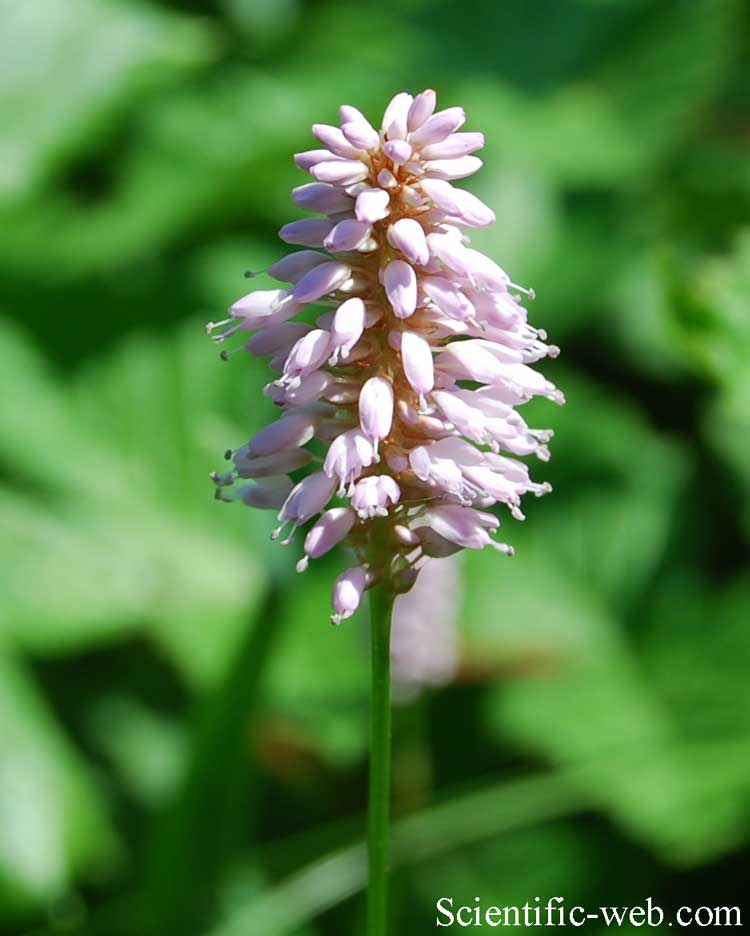
Bistorta officinalis, Photo: Michael Lahanas
Classification System: APG IV
Superregnum: Eukaryota
Regnum: Plantae
Cladus: Angiosperms
Cladus: Eudicots
Cladus: Core eudicots
Ordo: Caryophyllales
Familia: Polygonaceae
Subfamilia: Polygonoideae
Tribus: Persicarieae
Subtribus: Koenigiinae
Genus: Bistorta
Species: Bistorta officinalis
Name
Bistorta officinalis Delarbre
Synonyms
Persicaria bistorta Sampaio
Polygonum bistorta L.
References
Fl. Auvergne ed. 2, 2:516. 1800
USDA, ARS, Germplasm Resources Information Network. Bistorta officinalis in the Germplasm Resources Information Network (GRIN), U.S. Department of Agriculture Agricultural Research Service. Accessed: 09-Oct-10.
Vernacular names
العربية: أنجبار مخزني
azərbaycanca: İlanvari qırxbuğum
башҡортса: Йылан тамыр
български: Обикновено кървавиче
čeština: rdesno hadí kořen
dansk: Slangeurt
Deutsch: Schlangen-Knöterich, Wiesen-Knöterich, Schlangenwurz, Zahnbürste, Lauchelchen
English: common bistort, adderwort, dragonwort, easter giant, easter ledger, gentle dock, osterick, oysterloit, passion dock, pink pokers, pudding grass, red legs, snakeweed, twice writhen, water ledges
Esperanto: Bistorto
español: bistorta hembra, bistorta macho, bistorta menor, romaza retorcida, sierpe tendida, suelda Colorada
eesti: Ussitatar
فارسی: انجبار
suomi: Isokonnantatar
français: renouée bistorte
Gaelg: Bossan ardnieu
magyar: kígyógyökerű keserűfű
italiano: Bistorta
日本語: イブキトラノオ
ქართული: დვალურა
қазақша: Жылантаран
한국어: 범꼬리
lietuvių: Paprastoji gyvatžolė
latviešu: Zalkšu sūrene
Nederlands: Adderwortel, Addertong, Bloedkruid, Hertstong met Bloemen, Longenkruid, Miltkruid, Naterwortel, Slangenwortel
ирон: Сагалæг
polski: Rdest Wężownik
русский: Змеевик большой, Горец змеиный, Раковые шейки
slovenčina: hadovník väčší
slovenščina: Kačja dresen
svenska: Stor ormrot
українська: Гірчак зміїний
中文: 椭圆叶蓼
Bistorta officinalis (synonym Persicaria bistorta), known as bistort, common bistort, European bistort or meadow bistort, is a species of flowering plant in the dock family Polygonaceae native to Europe and northern and western Asia.[1] Other common names include snakeroot, snake-root, snakeweed and Easter-ledges.
Description
Bistorta officinalis is an herbaceous perennial growing to 20 to 80 centimetres (8 to 31 in) tall by 90 cm (35 in) wide. It has a thick, twisted rootstock which has probably given it its common name of snakeroot. The foliage is normally basal with a few smaller leaves produced near the lower end of the flowering stems. The leaves usually hairless; the basal ones are longish-oval with long winged stalks and rounded or heart-shaped bases; the upper ones are few and are triangular, tapered and stalkless. There are stipules at their base which are fused into a sheath surrounding the stem. The petioles are broadly winged. The inflorescence is a spike. The plant blooms from late spring into autumn, producing tall, erect, unbranched and hairless stems ending in single terminal racemes that are club-like spikes, 5–7 cm (2–3 in) long, of rose-pink flowers.[2] The individual flowers are pink with five perianth segments, eight stamens, three fused carpels and three free styles. The fruit is a glossy black nut. Flowering takes place in June and July.[3] The plant grows in moist soils and under dry conditions goes dormant, losing its foliage until adequate moisture exists again.
Taxonomy
The generic placement of this species was historically in flux, having been placed in Polygonum or Persicaria but is now accepted as Bistorta.[4]
Etymology
The Latin name bistorta, from bis ("twice") + torta ("twisted"), refers to the twisted appearance of the root.
Numerous other vernacular names have been recorded for the species in historical texts, though none is used to any extent. Many of the following refer to the plant's use in making puddings:
Adderwort
Dragonwort
Easter giant
Easter ledger
Easter ledges
Easter magiant
Easter man-giant
Gentle dock
Great bistort
Osterick
Oysterloit
Passion dock
Patience dock[5]
Patient dock
Pink pokers
Pudding grass
Pudding dock
Red legs
Snakeweed
Twice-writhen
Water ledges
Distribution and habitat
Bistort is a native of Europe but is often cultivated and has become naturalized in other parts of the world such as in the United States in New England. It is typically found growing in moist meadows, nutrient-rich wooded swamps, forest edges, wetlands, parks, gardens and disturbed ground.[6]
Cultivation
This species is grown as an ornamental garden plant, especially the form 'Superba' which has larger, more showy flowers, and has gained the Royal Horticultural Society's Award of Garden Merit.[7] It is suitable for use as a marginal or in bog gardens. Bistort has been cultivated as a vegetable, its roots, leaves and young shoots being steamed or boiled. Many of its occurrences in the wild may be as a garden escape.
Uses
It has also been used traditionally for medicinal purposes. The roots are rich in tannic and gallic acids and both these and the leaves have been used to treat wounds.[3]
In Northern England the plant was used to make a bitter pudding in Lent from a combination of the leaves, oatmeal, egg and other herbs. It is the principal ingredient of dock pudding or Easter-Ledge pudding.[8] The root of Bistort can be used to produce an astringent that was used in medicine. The roots are also eaten in Russia and northern Asia.[9]
Gallery
Common bistorta, in Valais, Switzerland
Bistort or Easter Ledges in the spring in Scotland.
Common bistort stem.
The large-flowered cultivar Bistorta officinalis 'Superba' is grown as an ornamental plant.
In Vitosha, Bulgaria
Seeds
References
"Bistorta officinalis Delarbre". Plants of the World Online. Royal Botanic Gardens, Kew. Retrieved 2019-03-01.
RHS A-Z encyclopedia of garden plants. United Kingdom: Dorling Kindersley. 2008. p. 1136. ISBN 978-1405332965.
"Bistort: Bistorta officinalis". NatureGate. Retrieved 2013-12-30.
Schuster et al 2015.
this name is also used for Rumex patientia
"Bistorta officinalis (meadow bistort)". Go Botany. New England Wildflower Society. Retrieved 2013-12-30.
http://apps.rhs.org.uk/plantselector/plant?plantid=3789[dead link]
Easter-Ledge or Dock Pudding - Historical Foods Archived 2011-06-24 at the Wayback Machine
Pieroni, Andrea (2005). Prance, Ghillean; Nesbitt, Mark (eds.). The Cultural History of Plants. Routledge. p. 35. ISBN 0415927463.
Bibliography
Schuster, Tanja M.; Reveal, James L.; Bayly, Michael J. & Kron, Kathleen A. (2015). "An updated molecular phylogeny of Polygonoideae (Polygonaceae): Relationships of Oxygonum, Pteroxygonum, and Rumex, and a new circumscription of Koenigia". Taxon. 64 (6): 1188–1208. doi:10.12705/646.5.
Retrieved from "http://en.wikipedia.org/"
All text is available under the terms of the GNU Free Documentation License

